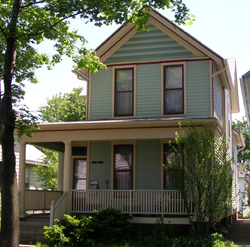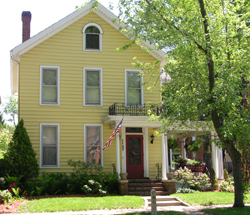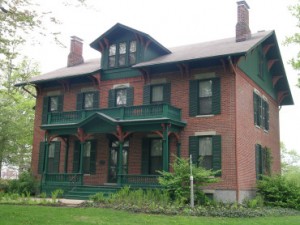
1424 West Jefferson Boulevard
Swinney Homestead
In 1844, Thomas Swinney had this original Federal-style home built for him, his wife Lucy, and their daughters. Thomas, an influential and wealthy landowner who was active in local affairs, was a strong advocate for the Republican Party. He served as justice of the peace, overseer of the poor, and two terms as Allen County treasurer.
The home was built using native Indiana walnut, poplar, and limestone. In 1886, the Swinney daughters remodeled the house in the Italianate style, adding the porch, the paired brackets, and the central wall dormer that simulates an Italian tower. The grounds became the Allen County Fairgrounds in 1874 and later became Swinney Park. Settlers, Inc. has leased the home since 1983 and led in its restoration.
Settlers, Inc. has been sharing the history of our ancestors through hand arts which demonstrate the many skills needed to survive early America. In 1980, they moved into the Swinney Homestead to teach classes in these arts. The restored 1849 Log House is used for Living History presentations.
–
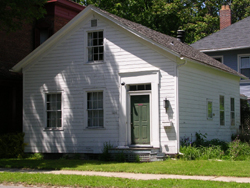
1104 West Jefferson Boulevard
Tom Cain
Standing as one of the oldest structures in the West Central neighborhood, this Greek Revival-influenced cottage was built circa 1852 for Frederick Schmiedes.
Very simple in design, characteristic features of this house include six-over-six, double-hung windows, many with the original wavy glass intact, divided transom light over the paneled front door, and the wide trim with “ears” or “shoulders” accenting the main entrance. Note the varied widths of clapboards on the main façade and the laid stone foundation. The rear third of the house was added in the late 19th- century and features two-over-two, double-hung windows. Inside, wide trim remains in original parts of the house as does a walnut stair railing with turned balusters.
Owner Tom Cain purchased this house last fall, and intends to rehabilitate the house to suit a contemporary lifestyle while respecting its historic features in an effort to preserve the structure for future generations to learn from and to enjoy. The house will be for sale after the work has been completed.
–
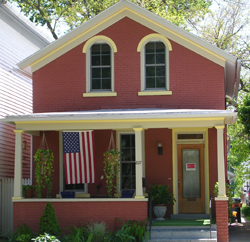
827 West Jefferson Boulevard
Michael Rogers
This gable-front house was built circa 1872. Constructed of brick, the house features a full-width front porch supported by single, square wood columns. Two windows highlighted with yellow-painted, brick arches enhance the second-story of the main façade. Inside, you’ll find a koi “pond” and a TV room outfitted with 1950’s modern furniture.
While not verified, it is suspected that German native Ernst Breimeier, who first owned the lot after the area was platted by Samuel Hanna, was involved in the construction of the house. Between 1872 and at least 1880, Ernst and his family lived next door in a similarly designed house. In 1889, it was written that Ernst was “one of the leading contractors and builders whose work has adorned Fort Wayne.” He contracted for several prominent Fort Wayne buildings including Emmanuel Lutheran Church.
Early known residents of the house included, from 1880-1881, Massachusetts native Joseph Godfrey, an engineer for the Wabash, St. Louis, and Pacific Railroad, his wife Nettie, their four children, a boarder, and a servant. Marcus Johnson, another Massachusetts native, and toolmaker/machinist with the Fort Wayne Electric Company, lived here from 1890 to 1904.
Owner Michael Rogers moved into the West Central neighborhood to be close to his engineering job at General Electric. He is now embarking on a new career as an interior designer, and is proud to be part of the West Central arts community. His home serves as a canvas for this latest aspiration.
–
This cross-gabled, Queen Anne-style house was built circa 1897 for Wilhelmina (Minnie) and Christian (Christ) Paul. Minnie’s parents, William and Louise Nahrwold, actually first owned the house, but lived next door at 817 Wilt Street. The Paul’s were married in 1896 and had four children. Over the years, Christ worked as an engineer for several employers including North Side High School. The Paul’s lived in this house the rest of their lives, and their daughter Helen lived here until her death at age 82 in 1984.
Since purchasing the house in 2002, owner Kay Gnagey has worked to bring its mechanical systems into the 21st century while restoring the exterior to its period condition. Blue aluminum siding was removed to reveal the original clapboard siding. In 2005, a new, architecturally-appropriate front porch, featuring a simple balustrade of square balusters and supported by single, round columns, was constructed. Other design details of the house include a brick foundation, scalloped siding on the front gable, crown molding over the tall, front windows, and a 4-color paint scheme to pull it all together. The services of an architectural historian friend helped with putting color and pattern back inside the house.
Kay researches, designs, and produces Civil War-era clothing, some of which will be on display today as will period china and glassware.
–
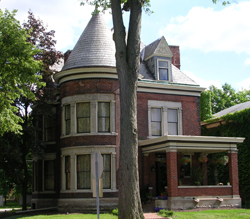
805 West Wayne Street
Worthington Mansion Bed & Breakfast
Tony Bishop and Kenson Dhanie
Built circa 1890 for Worthington and Clara Croxton, this brick, Queen Anne-style house exhibits attention to detail. Most notably is the full-height tower with curved windows. Other Queen Anne aspects of this house include the complex roofline with slate shingles, and dentil molding along the roof and front porch cornices. Note the ornamental design on the gable of the third floor dormer window. The windows on the main façade, in clusters of two and three, are surrounded in stone with stone pilasters between each window and at the ends of each cluster. The west side of the house features a one-story bay window, while a two-story bay window accents the east side.
Worthington and Clara Croxton were married in 1878. By the late 1880s, Worthington had become the secretary of the Western Gas Construction Company which started in 1888 and contracted in coal, water, and fuel, and gas works and apparatus. He left Western Gas in 1890 to pursue other interests, and Western gas went on to become, as it was stated at the time, “the largest and most successful of the kind not only in the United States, but in the world; had added much to Fort Wayne’s reputation as an important manufacturing point…its presence is a source of pride to the city…”.
After having served as office space since 1955, the interior of the house recently received a substantial makeover. Among the long list of projects was the removal of 1970s-era paneled walls and the re-opening and restoration of the main entrance and foyer.
–
501 West Berry Street
Plymouth Congregational Church
On Sunday, tours will begin at noon following the 10:45 a.m. service. Visitors are always welcome at Plymouth’s worship services. Volunteers from the church will be on hand to assist you in your tour of the structure.
Designed by architect Guy Mahurin in the Gothic Revival style, the fourth building to serve as Plymouth Congregational Church was completed in 1924. Built of Indiana limestone, the Gothic Revival features of the church may be seen in the pointed-arch windows, the stone buttress construction, and use of tracery (curvilinear shapes) to embellish exterior wall surfaces. A crenellated parapet caps the prominent, square bell tower. Other exterior details include carved stone acanthus leaves and rosettes. The western addition, built in 1956, is simpler in detail. >
Inside, Gothic Revival architecture continues. Pointed arches appear again, and tracery is used extensively to form a floral pattern on the ceiling. This same pattern is echoed in the carpet below. Tracery is also used to ornament the pew ends. Recent renovations to the church included the addition of the western porte cochère entrance, the refinishing and rearrangement of pews, expansion of the narthex area, and major upgrades to the electrical system.
Plymouth Church’s congregation, headed by the Reverend N.A. Hyde, was first organized in 1870. In 1935, it was reincorporated as Plymouth Congregational Church. It is well-known for its annual Christmas-time production of the Boar’s Head and Yule Log Festival, a colorful and energetic pageant first begun in Oxford, England in 1340 recognizing the boar as sovereign of the forest. The presentation of a boar’s head at Christmas came to symbolize the triumph of the Christ Child over sin.
(Historical information provided by Plymouth Congregational Church)
–
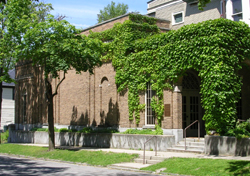
719 Rockhill Street
Arena Dinner Theatre
The Arena Dinner Theatre was originally known as The Little Art Theatre as it first served as a gallery for the Fort Wayne Art School. Built in 1922, it was designed by the local architectural firm of Wing and Mahurin as an addition to the rear of the Theodore Thieme house at 1026 W. Berry Street. It exhibits a simple, yet elegant Neoclassical exterior with tall, arched windows and arched entry vestibule. The double doors of the main entrance are accented by a fanlight.
The Arena Dinner Theatre is a non-profit community arts corporation devoted to the production of live theater performed and directed by the best experienced actors and directors in the area. Seven, full-length theatrical productions are featured each season in the theater which can accommodate up to 120 patrons. All meals served during the shows are prepared on-site and are served by a professional and courteous wait staff.
–
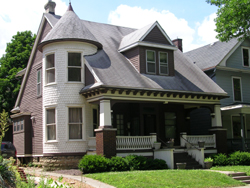
1235 West Berry Street (garden only)
Doug Kettelkamp
The backyard of this circa 1905 Queen Anne- style bungalow once was home to an old rusty shed and crumbling driveway, sidewalk, and steps. Owner Doug Kettelkamp has created an attractive garden highlighted by a series of small ponds and waterfalls built of Arkansas fieldstone. Leading from the street to the carriage house is a Dutch cobblestone sidewalk. Other features include a two-level deck with an integrated lighting system, and Dutch cobblestone patio. The simple plantings include hollies and grasses for year-round interest, and hostas. Large pots filled with asters and caladiums add color.
The house is House Design No. 5010 from the Harris Brothers Company of Chicago, Illinois. Its main feature is the two-story round tower accentuated with fishscale shingles. The porch is supported by two square, tapered columns and substantial brackets, and is embellished with large modillions along the cornice. The home was originally built for William and Laura Noll who lived here from 1905 to 1916.
William Noll started the Pinex Company in 1905 which by 1910, was manufacturing a cough remedy called “Pinex” that could be purchased in nearly any drugstore in the United States. With the Pinex profits, the Noll’s built a grand home at 2502 Fairfield Avenue (since demolished) which became the scene of many lavish parties. The house and furnishings were said to have cost over one million dollars. Also, several years before World War I, William operated the first liquid nail polish industry in the United States.
–
Although many of this house’s original architectural features are now covered up, a few typical Italianate details are still present such as the third-story arched widows topped with a thick crown or hood molding and the small, classical entry porch supported by narrow, round columns and ornamented with an iron railing on top. Back portions of the house were added on in later years.
Emily Rockhill, the fourth wife and widow of Fort Wayne pioneer William Rockhill, who platted much of the land of the West Central neighborhood, was the first to live in this circa 1868 Italianate house. The story goes that Emily was removed from the Rockhill family home by William’s children with his second wife, who was also Emily’s sister, after William’s death in 1865. Having inherited one-third of her husband’s estate, Emily had this house built for her.
Born in Vermont in 1824, Emily came to Fort Wayne with her family in 1837. She married William in 1862. Emily died in 1903 and was survived by five Rockhill step-children, two nephews, and a brother. She is buried in Lindenwood Cemetery in the Rockhill family plot.
(Historical information supplied by former owner Rod Collier)
–
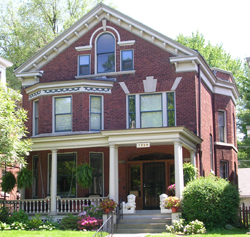
1209 West Wayne Street
Michele Fortune
This brick, Queen Anne/Colonial Revival house was built circa 1905 on land where the Fort Wayne College once stood. Displaying a skillful combination of various architectural details, the house features modillions under the front eaves and a classic Palladian window highlighting the front gable. Two-story bay windows are present on three sides of the house; that of the main façade exhibits a cornice ornamented with a garland detail. The full-width front porch, supported by smooth, round columns in singles and in pairs, has a turned spindle balustrade and dentil molding along the cornice. Flanked by sidelights and topped with a fanlight, the large front door provides a grand entrance to the main foyer of the house.
First residents Forest and Flora Gauntt lived in this house until 1910 and later lived at 1221 W. Wayne Street. While living here, Forest became the president of the Gauntt Manufacturing Company, and received a Patent Certificate in 1910 for a feeding device.
Fort Wayne natives Charles and Emma Gumpper lived here from 1910 to 1933. In 1910, Charles helped to organize the Grace Construction Company for which he served as president. The company installed asphalt and other street pavings throughout Fort Wayne. In 1917, the company employed 250 people and was considered to be “one of the strong and important industrial concerns of the Summit City.”
Owner Michele Fortune moved to Fort Wayne from the northeastern United States just last summer, and was attracted to the gracious, old neighborhood of West Central and its close proximity to downtown and community events. Upon seeing this house, she immediately fell in love with its charm and details: the spacious front porch, wood floors, woodwork, and the courtyard garden.
–
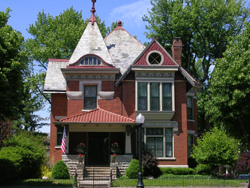
1202 West Washington Boulevard
Kim and Debbie Krauhs
This masonry house is an exceptional example of the Queen Anne style. Designed by the local architectural firm of Wing & Mahurin in 1885, architectural features include a square tower with an eyebrow dormer, a projecting gable with a shallow oriel window, and brickwork accented with stone details. The porches were built c.1910 in the Craftsman style, with tapered square columns, exposed rafters, and tile roofs. The iron fence around the yard is original to the property.
The house is associated with Joseph A.M. Storm, who came to Fort Wayne from Germany in 1864 at the age of seventeen. Twice elected to the Fort Wayne City Council, he first worked as a clerk in a hardware store and then went into the hardware business for himself. In approximately 1894, he sold the business to J.C. Peters & Company and moved with his family to Petoskey, Michigan. He died at the age of 49 in 1896.
When Kim and Debbie bought this home five years ago, it was already in the middle of being rehabilitated. Since then, they have worked to complete many projects including a complete remodeling of the kitchen which features custom cabinets and modern, state-of-the-art appliances. The three downstairs fireplaces were restored (two were fitted with gas logs and one has a reproduction electric coal basket), and a bookcase was constructed within an unused doorway from the side entrance to the back parlor. Outside, a large, two-story garage sits at the rear of the spacious backyard. Bricks salvaged from a previously-existing path were used to construct the raised patio.


